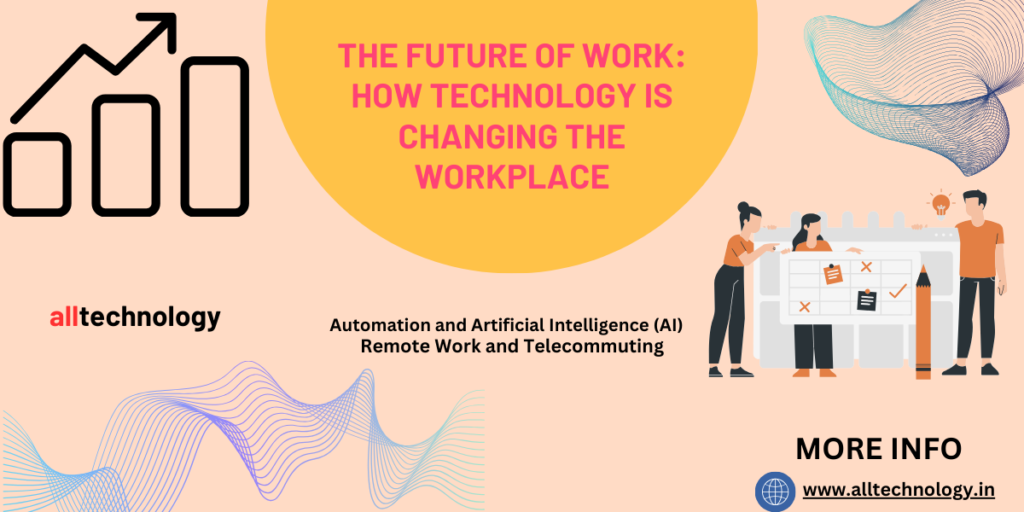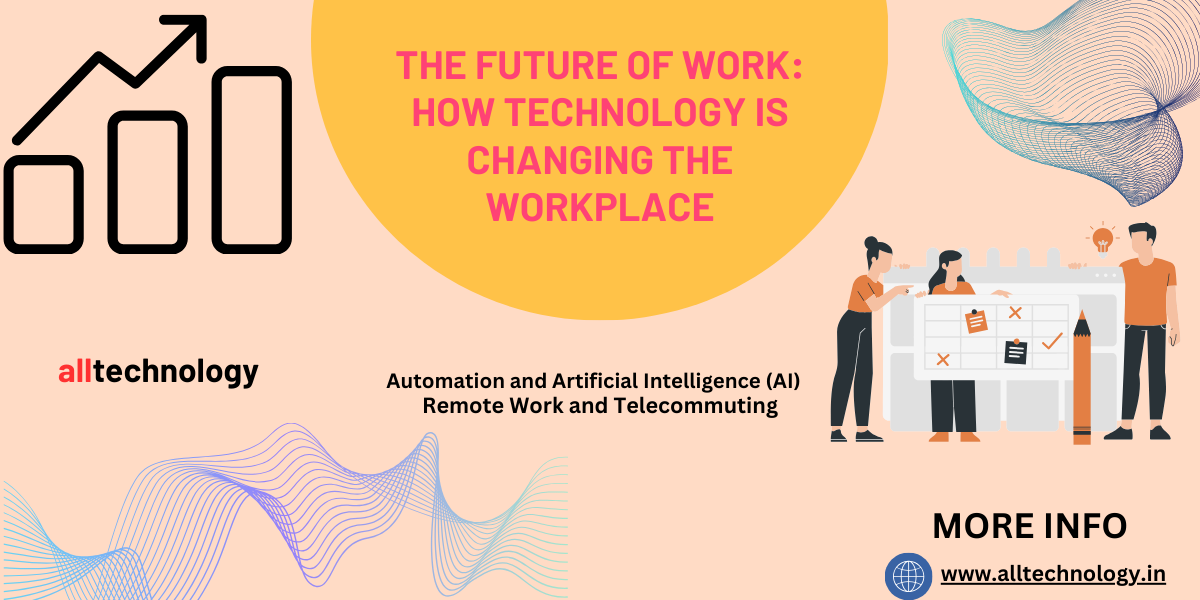Introduction
Hello Bloggers welcome alltechnology blog. In this blog you will learn The Future of Work: How Technology is Changing the Workplace. In today’s rapidly evolving world, the workplace is undergoing significant transformations, driven predominantly by technological advancements. These changes are reshaping how we work, where we work, and the nature of work itself. The future of work, a concept often discussed in both academic and professional circles, is now more relevant than ever.

The Future of Work: How Technology is Changing the Workplace
1. Automation and Artificial Intelligence (AI)
In recent years, the advent of automation and artificial intelligence (AI) has fundamentally transformed the workplace. Machines, with their remarkable efficiency and precision, are now capable of performing tasks that were once exclusively in the human domain. From customer service chatbots to sophisticated data analysis algorithms, AI is revolutionizing how businesses operate. This shift, however, also raises concerns about job displacement and the need for workers to adapt to new roles that require advanced technical skills.
2. Remote Work and Telecommuting
The rise of digital communication tools has made remote work more feasible and widespread than ever before. Video conferencing platforms, project management software, and collaborative online spaces have enabled employees to work from anywhere in the world. This flexibility offers numerous benefits, such as improved work-life balance and reduced commuting times. However, it also poses challenges in terms of maintaining team cohesion and managing remote employees effectively.
3. Gig Economy and Freelancing
The gig economy is another significant trend reshaping the modern workplace. Platforms like Uber, Upwork, and Fiverr have popularized freelance and contract work, allowing individuals to take on short-term jobs or “gigs.” This model provides greater freedom and autonomy for workers, but it also often lacks the stability and benefits associated with traditional full-time employment. As a result, gig workers must navigate an unpredictable income stream and limited access to benefits like health insurance and retirement plans.
4. Advanced Robotics and Manufacturing
In manufacturing, advanced robotics are making production processes faster, safer, and more efficient. Robots can perform repetitive tasks with high precision, reducing the risk of human error and workplace injuries. They are also being used in hazardous environments where human presence would be dangerous. Despite these advantages, the integration of robotics in manufacturing necessitates significant investment and the potential for substantial workforce restructuring.
5. Virtual and Augmented Reality (VR/AR)
Virtual and augmented reality technologies are opening new avenues for training, collaboration, and customer engagement. In the workplace, VR and AR can simulate real-world scenarios for training purposes, allowing employees to practice skills in a safe and controlled environment. Additionally, these technologies enhance remote collaboration by providing immersive experiences that can bridge geographical distances. However, the adoption of VR and AR requires substantial initial investment and ongoing maintenance.
6. Blockchain and Secure Transactions
Blockchain technology, initially developed for cryptocurrency transactions, is now being explored for various business applications. Its ability to provide secure, transparent, and tamper-proof records makes it ideal for supply chain management, financial transactions, and contract enforcement. By decentralizing data storage and verification, blockchain can enhance security and trust in digital transactions. Nevertheless, its implementation can be complex and requires significant technological infrastructure.
7. Internet of Things (IoT)
The Internet of Things (IoT) connects everyday devices to the internet, enabling them to collect and exchange data. In the workplace, IoT can streamline operations, improve resource management, and enhance productivity. Smart office systems, for example, can optimize energy usage, track equipment status, and facilitate predictive maintenance. While IoT offers substantial benefits, it also raises concerns about data security and privacy.
8. Cybersecurity and Data Protection
As technology becomes more integrated into the workplace, the importance of cybersecurity cannot be overstated. Protecting sensitive information from cyber threats is crucial for maintaining business integrity and customer trust. Advanced cybersecurity measures, such as encryption and multi-factor authentication, are essential to safeguard data. However, staying ahead of evolving cyber threats requires continuous vigilance and investment in the latest security technologies.
9. Collaborative Tools and Platforms
The proliferation of collaborative tools and platforms has transformed how teams work together. Software like Slack, Microsoft Teams, and Trello facilitate seamless communication and project management, allowing team members to collaborate in real-time. These tools support flexible work arrangements and enhance productivity by centralizing information and streamlining workflows. Despite their advantages, the reliance on digital tools can lead to information overload and necessitates effective management strategies.
10. Continuous Learning and Skill Development
In an era of rapid technological advancement, continuous learning and skill development are essential for staying competitive in the job market. Employers are increasingly prioritizing employees who demonstrate adaptability and a willingness to learn new skills. Online courses, workshops, and certifications provide opportunities for professional growth and development. Nevertheless, the pressure to constantly update one’s skills can be daunting and requires a proactive approach to career management.
The Evolution of Work Environments
Technology has catalyzed a seismic shift in traditional work environments. Remote work, once a perk offered by a few progressive companies, has become a widespread necessity. Digital tools and platforms enable seamless collaboration across continents, breaking down geographical barriers. Offices are no longer defined by physical space but by digital connectivity, fostering a new kind of workplace flexibility.
Automation and Artificial Intelligence
Automation and AI are at the forefront of this transformation. Routine tasks, once performed by humans, are increasingly being handled by sophisticated algorithms and machines. This shift not only boosts efficiency but also demands a rethinking of the roles humans play in the workplace. Complex problem-solving, creative thinking, and emotional intelligence are becoming invaluable skills, setting the stage for a workforce that thrives on human ingenuity.
The Gig Economy and Freelancing
The gig economy exemplifies the changing nature of employment. Traditional nine-to-five jobs are being supplemented, and in some cases replaced, by freelance and contract work. Platforms like Upwork and Fiverr facilitate this shift, offering workers unprecedented autonomy and flexibility. However, this trend also brings challenges, such as job security and benefits, prompting discussions on the future of labor laws and worker protections.
Lifelong Learning and Skill Development
As technology evolves, so too must the workforce. Lifelong learning has become a crucial element of career development. Continuous education, through online courses and professional training, ensures that employees remain relevant in an ever-changing job market. Companies are increasingly investing in the upskilling and reskilling of their workforce, recognizing that adaptability is key to staying competitive.
The Role of Leadership in a Technological Era
Leadership in this new era requires a different approach. Leaders must not only embrace technology but also inspire and guide their teams through these transitions. Emotional intelligence, adaptability, and a forward-thinking mindset are essential traits for modern leaders. They must foster an inclusive and innovative culture, where technology enhances rather than hinders human potential.
Conclusion
The future of work is not a distant concept but a present reality. Technology continues to redefine the workplace, offering both opportunities and challenges. By understanding these changes and adapting accordingly, both individuals and organizations can thrive in this new era. The key lies in embracing the possibilities technology offers while nurturing the uniquely human skills that machines cannot replicate.
FAQ
Question 1. How is technology changing the work of the future?
Technology is enabling work to be more about tasks and less about job positions, allowing workers more choice on how and where to complete the tasks. Research shows that those who choose flexible working arrangements out of preference, not necessity, are positive about future changes to the workplace.
